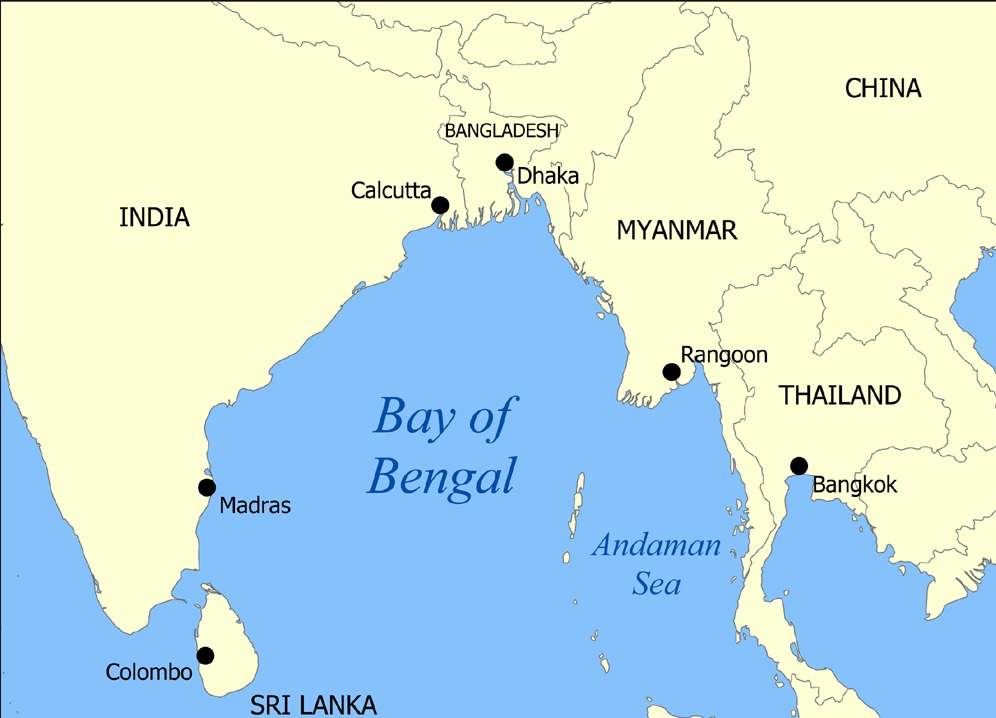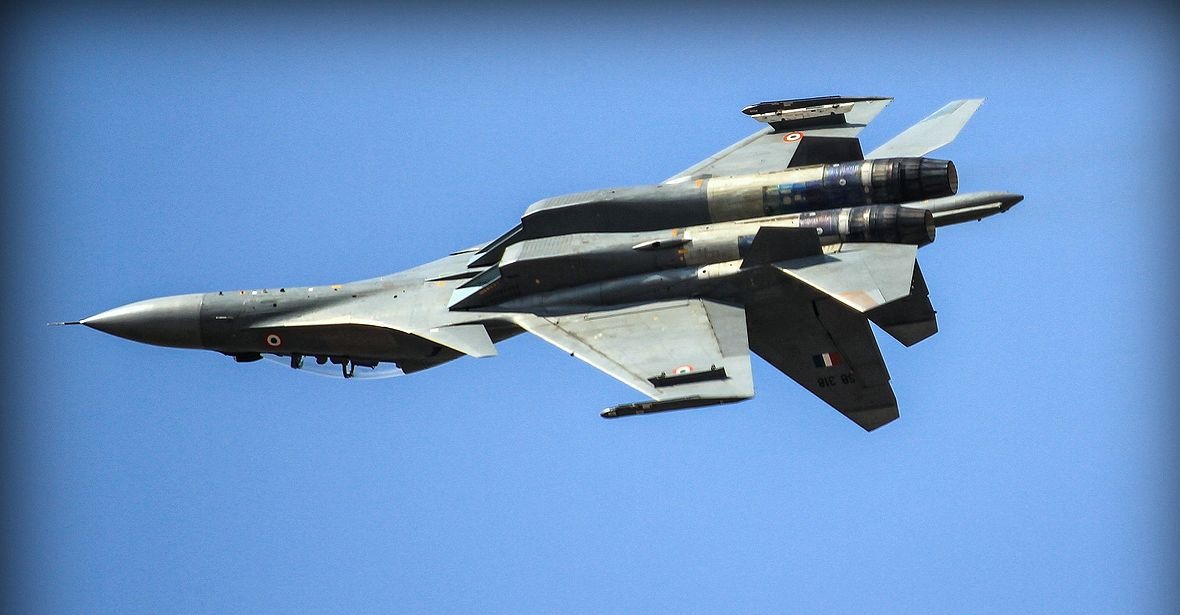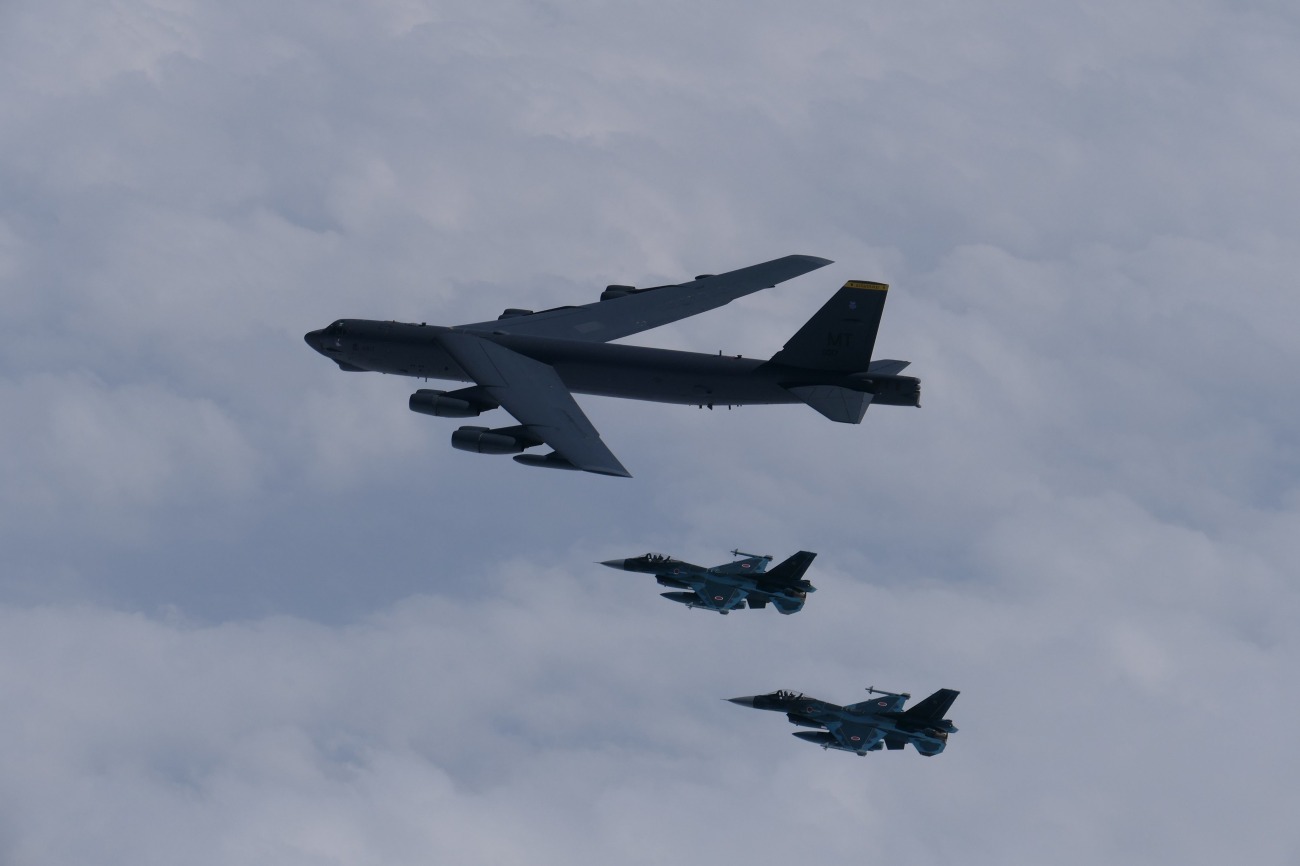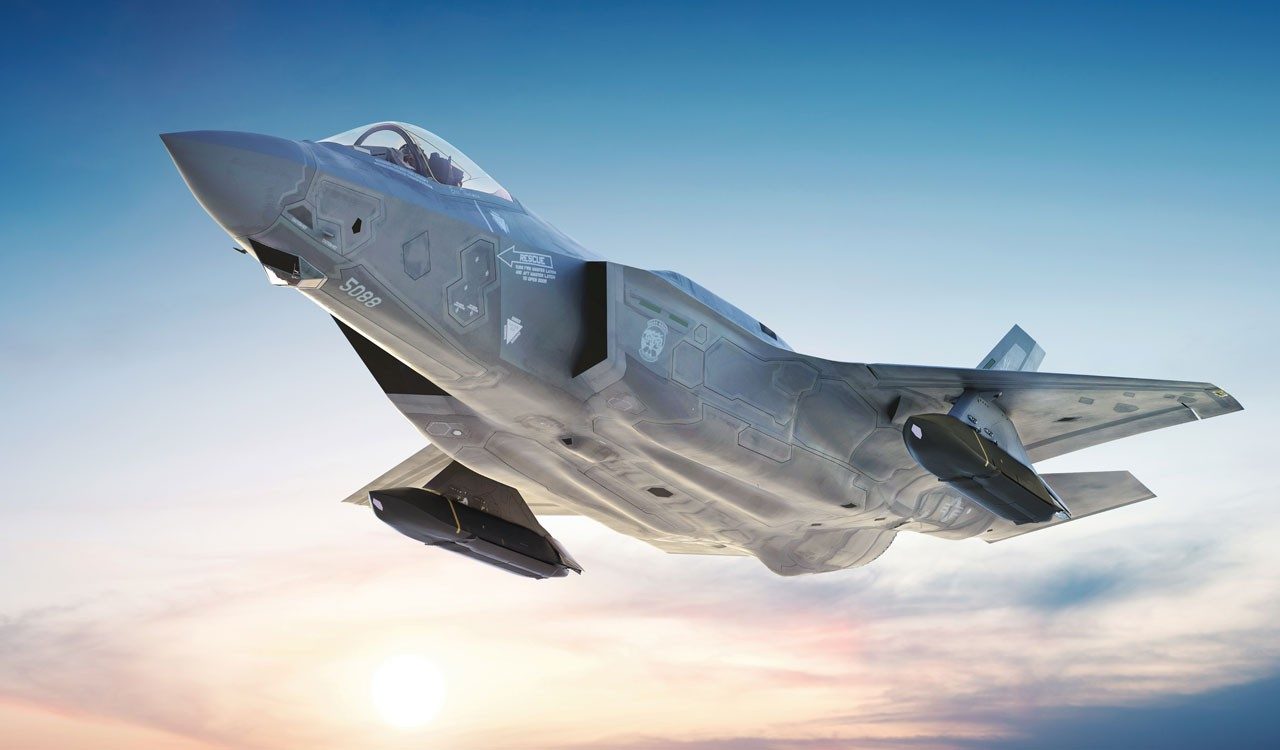As the focus of global geopolitical and strategic action shifts more towards the Indo-Pacific, other than the South China Sea (SCS) and the Gulf of Thailand (Ream Naval base, Cambodia), significant interest is developing in the Bay of Bengal (BoB).
The US has been interested in building a naval and air station on Bangladesh’s Saint Martin Island. China is investing more heavily in Bangladesh’s military assets and ports. India has plans to strengthen the airfields on its eastern seaboard and in the Andaman and Nicobar Islands.
The relatively peaceful Bay of Bengal (BoB) has suddenly become a focus of the strategic community. It last saw major action during the Burma and Arakan Campaigns in WWII and, of course, during the liberation of Bangladesh in 1971.
Even the USS Enterprise (CVN-65) aircraft carrier and Soviet nuclear submarines visited the BoB during the 1971 Bangladesh Liberation War. Most airfields around the Bay of Bengal were either initially built during WWII or, especially in Thailand, built by the US during the Vietnam War.
The Bay Of Bengal
The 2.6 million square kilometers BoB includes Bangladesh, India, Indonesia, Malaysia, Myanmar, Sri Lanka, and Thailand as the Basin countries. It is situated in the northeastern part of the Indian Ocean and has a maximum length of 2,090 km and a maximum width of 1,610 km.
At its deepest point, it is 4,694 m (15,400 ft) deep. Many South Asian and Southeast Asian countries are dependent on this world’s largest bay.
The major feature is the Andaman and Nicobar Islands of India. The southern limit of the BoB is the line between Sangaman Kanda, Sri Lanka, and the northwesternmost point of Sumatra, Indonesia. Cox’s Bazar is the longest sea beach in the world, and the Sundarbans, the largest mangrove forest and the natural habitat of the Bengal Tiger are located along the bay.
A number of large rivers flow into the Bay of Bengal, including the Ganges-Hooghly, the Padma, the Brahmaputra–Jamuna, the Barak-Surma-Meghna, the Irrawaddy, the Godavari, the Mahanadi, the Brahmani, the Baitarani, the Krishna, and the Kaveri.
The bay gets its name from the historical Bengal region, which once comprised modern-day Bangladesh, the Indian states of West Bengal, Tripura, and the Barak valley of Southern Assam.

In Ancient Indian scriptures, this water body was also referred to as Mahodadhi (Great water receptacle). Ancient Greeks called it the “Gulf of the Ganges.” Some Sanskrit texts call it the ‘Eastern Ocean.’ Another name was the Kalinga Sagar (Kalinga Sea). The Chola dynasty’s navy (9th century to 12th century) controlled the Bay of Bengal, also called the Chola Sea or Chola Lake.
In the 16th century, the Portuguese built trading posts in the northern BoB at Chittagong (Porto Grande) and Satgaon (Porto Pequeno). As early as 1858, Ross Island, a part of the Andaman Island Chain, was used as a British penal colony for political prisoners facing life imprisonment. In 1896, the Cellular Jail was built. Ross Island was one of the main naval bases of India during World War II.
World Heritage Site Konark, the home of the Sun Temple, was built using black granite in mid-1200 AD. Jagannath Temple at Puri is one of the four sacred places in Hindu pilgrimage. Ramanathaswamy Temple was built at Dhanushkodi, where the BoB and the Gulf of Mannar come together.
Coral reefs, tsunamis, cyclones, mangrove swamps, battles, and a crisscross of sea routes in a high-trading area are other features of BoB. The English East India Company and the French East India Company began trading in the 18th century, and Gopalpur-on-Sea was one of their main trading centers.
BIMSTEC (Bay of Bengal Initiative for Multi-Sectoral Technical and Economic Cooperation) supports free trade internationally around the BoB between Bangladesh, Bhutan, India, Myanmar, Nepal, Sri Lanka, and Thailand. Approximately 31 percent of the world’s coastal fishermen live and work on the bay.
The region experiences extreme cyclones that affect both India and Bangladesh. Over 100,000 were killed in Bangladesh during the 1970 Bhola cyclone. In 1999, a super cyclone killed nearly 10,000 in Odisha. Other extremely severe cyclonic storms were Mocha (2023) and Fani (2019).
Geostrategic Importance: Bay Of Bengal
The BoB is at the center of two huge economic blocks, the SAARC and ASEAN. It influences China’s southern landlocked region in the north and major sea ports of Bangladesh and India. The Andaman and Nicobar Islands and major ports, such as Chittagong, Mongla, Payra, Paradip, Kolkata, Chennai, Visakhapatnam, and Tuticorin, are part of BoB.
One of the most important shipping lanes in the world passes through the Strait of Malacca and enters southern BoB. It links major Asian economies to the rest of the world. Nearly 100,000 vessels pass through the strait each year, making it the busiest strait in the world, carrying about 25 percent of the world’s traded goods.
The maritime boundary disputes between Bangladesh and Myanmar and between India and Bangladesh have been mostly resolved. Disputes over the rights to some oil and gas blocks have caused brief diplomatic spats between Myanmar, India, and Bangladesh.
China has recently made efforts to project influence into the region through tie-ups with Myanmar and Bangladesh. China, India, and Bangladesh work together with Malaysia, Thailand, and Indonesia to check terrorism in the high seas.
The United States and many major navies worldwide exercise together in BoB. Exercise Malabar is one of the biggest such exercises.
Naval Action
In 1942, SS Selma City, attacked by Japanese bombers in the BoB, sank about 40 km offshore from Visakhapatnam, India. HMS Hermes, the world’s first purpose-built aircraft carrier, sank after receiving 40 direct hits from 70 Mitsubishi A6M Zero fighter/bombers off the coast of Sri Lanka. On 3rd December 1971, the Pakistan Navy submarine PNS Ghazi was sunk near Visakhapatnam.
Major IAF Airbases In The Bay Of Bengal
One of IAF’s largest airbases overlooking BoB is Kalaikunda near Kharagpur in West Bengal. It is around 90 kilometers from the coast. Originally built in 1943 during World War II, it was later upgraded by the Americans for B-29 Superfortress. It saw major action during the 1965 and 1971 wars.
Today, it is a Su-30 MKI base. Air Force Station Arjan Singh, at Panagarh near Durgapur, is a little deeper (190 km) but relevant. Again, an American bomber base in WWII now has C-130J aircraft.
Tambaram Airbase, near Chennai, Tamil Nadu, is primarily involved in flying training. Its 6,000-foot runways can be used for transport operations and limited fighter ops. Thanjavur Airbase, in the southern peninsula, has an over 11,000-foot runway and hosts Su-30 MKI aircraft.

It is just 50 km from the coast. Sulur airbase, albeit a little deeper in the peninsula (300 km from BoB), is a relevant base that hosts the Indigenous LCA “Tejas.” The IAF airbase at Car Nicobar has a 9,000-foot runway and can handle all kinds of fighter aircraft operations.
The runway is planned to be extended further, and infrastructure is being built to locate fighter squadrons for much longer durations. The distance from Car Nicobar to Malacca Strait is just 900 km. A Su-30 operating from Carnic can make a combat mission until the middle of SCS with just one aerial refueling.
Major Indian Navy Airbases
INS Dega is the naval air station at Visakhapatnam, Andhra Pradesh. It has two runways with the larger one being 10,000 ft. It hosts a fighter training squadron BAE Hawk AJT aircraft, Dornier 228, Chetak helicopters, Sikorsky UH-3 Sea King helicopters, and an anti-submarine warfare squadron operating Kamov Ka-28 helicopters.
INS Rajali is near Arakkonam, Tamil Nadu, just 65 km from the coast. At 13,460 ft, it has Asia’s longest military runway. It is the home base for P-8I Neptune.
INS Utkrosh, Port Blair, was the first naval air station in the Andaman and Nicobar Islands. It has an 11,000-foot runway. Dornier 228 aircraft reconnaissance squadrons and Chetak and ALH helicopters are permanently stationed here. All IAF and Indian Navy aircraft can operate from here.
INS Baaz, Campbell Bay, is India’s southernmost regular airstrip. It is a full-fledged “forward operating base” of the Indian Navy. It overlooks the six-degree Channel, one of the world’s most crucial shipping lanes and a vital choke point.
There is a 3,445 ft asphalt runway. Currently, only the Dornier 228 aircraft and some helicopters operate here regularly. The IAF C-130J Super Hercules transport aircraft can also operate. There are plans to extend the runway to 10,000 feet to operate the Indian Navy’s Boeing P8i Poseidon surveillance aircraft with anti-submarine capabilities.
The 3,300-foot runway at INS Kohassa, Shibpur, North Andaman Island, is planned to be extended. It will one day have new ammunition dumps and capacity upgrades for fighter jets and bigger planes like long-range maritime reconnaissance Boeing P-8I and anti-submarine aircraft.
INS Parundu is near Uchipuli in Ramanathapuram, Tamil Nadu, very close to Sri Lanka. It currently has a 3,000-foot runway and operates Chetak helicopters, Islanders, and Dornier 228 reconnaissance aircraft.
Bangladesh Air Force Bases
Bangladesh Air Force has around 17,400 active duty personnel. It operates MiG-29 and Chengdu F-7 fighters, and a few C-130J, C-130, An-32, L-410 aircraft.
Kurmitola (Bangabandhu airbase) was built in the 1940s for Allied operations. It has an 11,500-foot runway shared with Hazrat Shahjalal International Airport, which serves Dhaka City. It is the main fighter base, hosting F-7 variants and MiG-29s.
Tejgaon Airbase in Dhaka served as the country’s sole international airport prior to the construction of Hazrat Shahjalal International Airport. The Bashar airbase at Tezgaon has Bell 212, Mi-17, Special Flying Unit C-130, and L-410 transport aircraft. Chittagong Zahurul-Haque airbase operates F-7, An-32, Yak 130, Mi-17 Bell 212, AW139.
Cox’s Bazar Forward Operating Base has a 10,000 ft runway and is the fifth main operating air base. Currently, it has no permanent flying units. It has separate military and civil enclaves. The Jessore Matiur Rahman airbase hosts the Air Force Academy. Built to take on the Japanese in WWII, it has an 8,000 ft runway and can take on fighter operations.
Myanmar Airbases
Mingaladon Air Base shares the runway with Yangon International Airport, Myanmar. Built in WWII, it has an 11,000-ft runway and hosts the Air Force VIP Squadron. Hmawbi Air Base is north of Yangoon and operates the MiG 29s and Yak-130 aircraft.
Magway Airbase is 170 km from the BoB and has an 8,491-ft runway. It has several types of fighter aircraft and hardened shelters. The Myeik Airbase is down south, just next to the Andaman Sea.
Taungoo Air Force Base has a full-fledged runway and is 250 km north of Yangoon. It currently hosts a helicopter unit. Meiktila Air Force Base has a runway but is currently used for ground training and is home to Central Command HQ. Shante Air Force Base, located north of Meiktila in Pyitharyar, is used for flying training.
Myanmar Air Force operates Sukhoi SU-30 (8), Chengdu F-7M Airguard (25), Mikoyan MiG-29 (26), A-5C (21), Hongdu K-8 Karakorum (50), and Pilatus PC-7 Turbo Trainers.
India’s Hindustan Aeronautics Limited (HAL) exported Sukhoi and MiG spares to the Myanmar military. In July 2015, Myanmar ordered 16 Block 2 JF-17s from Pakistan. As of April 2024, it has been reported that 11 JF-17 Thunder jets remain grounded.
Thailand Airbases
Most Air Bases in Thailand were built and maintained by the USA. Korat Royal Thai Air Force (RTAF) base is in northeast Thailand, approximately 200 km from Bangkok. During the Vietnam War, from 1962 to 1975, Korat was a front-line facility of the United States Air Force (USAF) in Thailand.
Korat is a major facility for the annual multinational Cope Tiger exercises, which involve air forces from the United States, Thailand, and Singapore, as well as U.S. Marine Corps aircraft deployed from Japan.
Takhli airbase in central Thailand is 240 km northwest of Bangkok. It hosts an F-16A/B MLU squadron, Light Attack Squadron, flying T-50 TH Golden Eagle, among others.
U-Tapao–Rayong–Pattaya International Airport (Utapao) is a joint civil-military airbase in Pattaya, eastern Thailand, 140 km southeast of Bangkok. The United States built U-Tapao to accommodate B-52 bombers. The remaining Thai airbases are quite far from BoB.

Indonesian Airbases Near Bay Of Bengal
Indonesia was under Soviet influence (1962–1965) and the influence of American and allied products (1980–1998), and since 2010, it has followed the principle of Minimum Essential Force (MEF).
The Westernmost airport, Sultan Iskandar Muda International Airport or Banda Aceh Airport (Bandar Udara Banda Aceh), has a 10,000-ft runway. It was built by the Japanese in WWII and is just 225 km from India’s Campbell Bay.
Maimun Saleh Airport is a small domestic airport in Sabang with a 6,050 ft runway. It is less than 200 km from Campbell Bay and is considered to be Indonesia’s westernmost and northernmost airport. The airport has a naval enclave.
The Indonesian Air Force Operates F-16s, Su-27s, Su-30s, Hawk 209s, and T-50is, among other aircraft. Its main action is against SCS.
Royal Malaysian Air Force
Royal Malaysian Air Force (RMAF) operates F/A-18 Hornets and Su-30 MKM fighters. As a part of Malaysia’s Multi-Role Combat Aircraft (MRCA) program, they are looking to replace its aging MiG-29 and F-5 fighters. Contenders are similar to the Indian Air Force.
Their main airfields facing BoB are Langkawi International Airport in Padang. The airport also hosts the biennial Langkawi International Maritime and Aerospace Exhibition (LIMA).
Sultan Abdul Halim Airport in Kepala Batas, Kedah, Malaysia. The RMAF training division is also co-located and uses the same runway. Penang International Airport in George Town is the country’s second-largest and overlooks the Malacca Strait.
RMAF Butterworth is an active Air Force Station in Penang. Although the airfield is now an RMAF base, the Royal Australian Air Force (RAAF) remains a co-tenant of the base. Butterworth routinely supports deployments of RAAF combat aircraft and has been made fit for the RAAF’s new Lockheed Martin F-35 Lightning II.

RMAF units at Butterworth include Boeing F/A-18D Hornets, BAE Hawk 108/Hawk 208, and AgustaWestland AW139. RAAF Boeing P-8 Poseidon is present at this only permanent air base outside of Australia. Most other RMAF bases are far away from BoB.
Sri Lankan Airbases
Sri Lankan Air Force (SLAF) has been looking for replacements for its Kfirs and MiG-27s. Pakistan’s offer of JF-17 Thunder aircraft was rejected on merit.
Seven surviving Mig23/27 aircraft are not operational. SLAF currently operates a few Chinese F-7 variants, five Kfirs fighters, two C-130 transports, four Antonov-32 transports, three Mi-17 helicopters, and its remaining Mi-35 attack helicopters.
In February 2022, the US agreed to provide two Beechcraft 360ERs on a gratis basis under foreign military sales. In August 2022, the Government of India delivered one Dornier Do228 as a grant with another on order, following crew training. The Australian Government has announced that it will gift a former Royal Australian Air Force Beechcraft KA350 King Air aircraft.
There are a few airfields overlooking BoB. China Bay is an air force base and domestic airport approximately 7 km southwest of Trincomalee on the east coast. Hingurakgoda SLAF airbase is also a domestic airport around 50 km from the east coast. It has a 7,503-foot runway. Currently, most SLAF helicopters operate here.
SLAF Katunayake is the largest airbase very close to Colombo. It has the most units, including fighters, transports, and helicopters. Though on the West Coast, it remains relevant.
Iranamadu airbase cum civil airport is in northern Sri Lanka, close to the town of Kilinochchi. Originally built by the rebel Liberation Tigers of Tamil Eelam in 2003, it was taken over by the Sri Lanka Air Force in 2009. This northernmost airbase has a 4,900 ft long runway.
To Summarize
The bulk of the airbases in and around the BoB were established during WWII and some during the Vietnam War. India has been one of the major countries that has built new ones or significantly upgraded old ones. Thailand, Malaysia, and Indonesia mostly have civil-centric dual-use airfields.
The Bay of Bengal has been relatively peaceful, but there has been action in Myanmar, Bangladesh, which just had a revolt, and Sri Lanka, which is still recovering from an economic mess and Civil War.
China needs connectivity to BoB to bypass the Malacca Strait. BoB is crucial to its BRI projects. China wants to exploit Bangladesh’s dependency for geopolitical purposes.
The Bay of Bengal is important for the USA in its Indo-Pacific strategy to checkmate China. The US wants India to be an ally and wants a friendly regime in Bangladesh.
India has a clear “Look East and Act East Policy.” It has enjoyed 15 years of friendly Bangladesh. The country is important for better connectivity to its north-east and also to ASEAN nations.
India wants to dominate BoB and is willing to support the neighborhood through SAGAR and BIMSTEC initiatives. BoB is also crucial to India because of the nuclear submarine base and huge strategic oil storage facilities
Air power is the fastest means of intervention. It is a great asset for HADR and economic aid missions. Fully developed airfields make a huge difference and are critical for the application of air power.
- Air Marshal Anil Chopra (Retired) is an Indian Air Force veteran fighter test pilot and former Director-General of the Center for Air Power Studies in New Delhi. He has been decorated with gallantry and distinguished service medals while serving in the IAF for 40 years.
- He tweets @Chopsyturvey
- Follow EurAsian Times on Google News




